Fort Worth’s Frontier Centennial surely was the whoopingest whoop-de-do that Cowtown has ever whooped up, eclipsing celebrations of the coming of the railroad in 1876, the Texas Spring Palace exhibition in 1889-1890, the packing plants in 1903, the bomber plant and adjacent Army airfield in 1941, and the city’s centennial in 1949.
In 1936, as Texas celebrated its centennial, Dallas (Fort Worth’s downstream arch rival) was selected to host the official state celebration at the state fairground. So, Fort Worth decided to offer an alternative, a little cultural counterprogramming: a simple pioneer-days celebration arranged by local volunteer women and Boy Scouts.
And then Amon Carter got involved.
Fort Worth’s head cheerleader had a grander vision. Not content to rely on Boy Scouts and women’s clubs, Carter imported New York nightclub owner and Broadway producer Billy Rose (husband unto Fanny Brice) to be straw boss of a pure-dee centennial extravaganza. Rose’s remuneration: one thousand dollars a day for one hundred days. (That’s a per diem of $16,000 in today’s dollars.) Backed by Carter’s hand-shaking, arm-twisting, and check-writing, Fort Worth would out-Dallas Dallas, by Gawd. Fort Worth would host its own centennial celebration on a grand scale, spread over a sprawling complex of buildings and midway built on 162 acres that the city had bought from the estate of Major Khleber Miller Van Zandt. (During World War I the land had been part of Camp Bowie.)
Carter also wrangled government funds for the city to build Will Rogers Auditorium and Coliseum, the foundation of today’s cultural district. The complex was built on the centennial grounds and in 1936 named for Carter’s late friend Will Rogers, who had been killed in 1935.
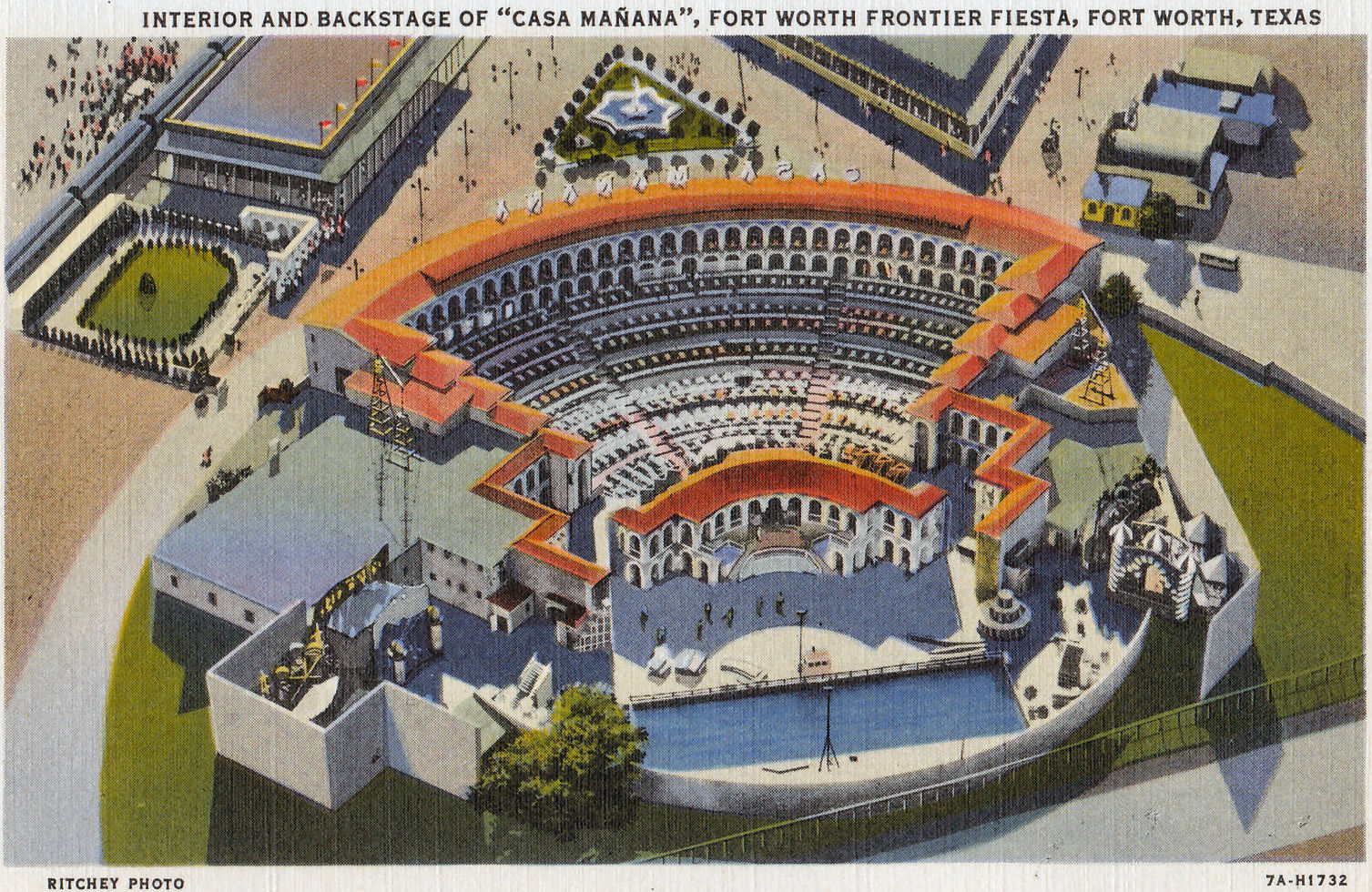 But the centerpiece of all that Frontier Centennial real estate was Casa Manana, an elegant four-thousand-seat cafe-amphitheater designed by architect Joseph Pelich. (After ballroom dancer-turned-flight instructor Vernon Castle was killed at Carruthers Field in Benbrook in 1918, Pelich replaced him and became chief flying instructor at the three airfields of Camp Taliaferro.)
But the centerpiece of all that Frontier Centennial real estate was Casa Manana, an elegant four-thousand-seat cafe-amphitheater designed by architect Joseph Pelich. (After ballroom dancer-turned-flight instructor Vernon Castle was killed at Carruthers Field in Benbrook in 1918, Pelich replaced him and became chief flying instructor at the three airfields of Camp Taliaferro.)
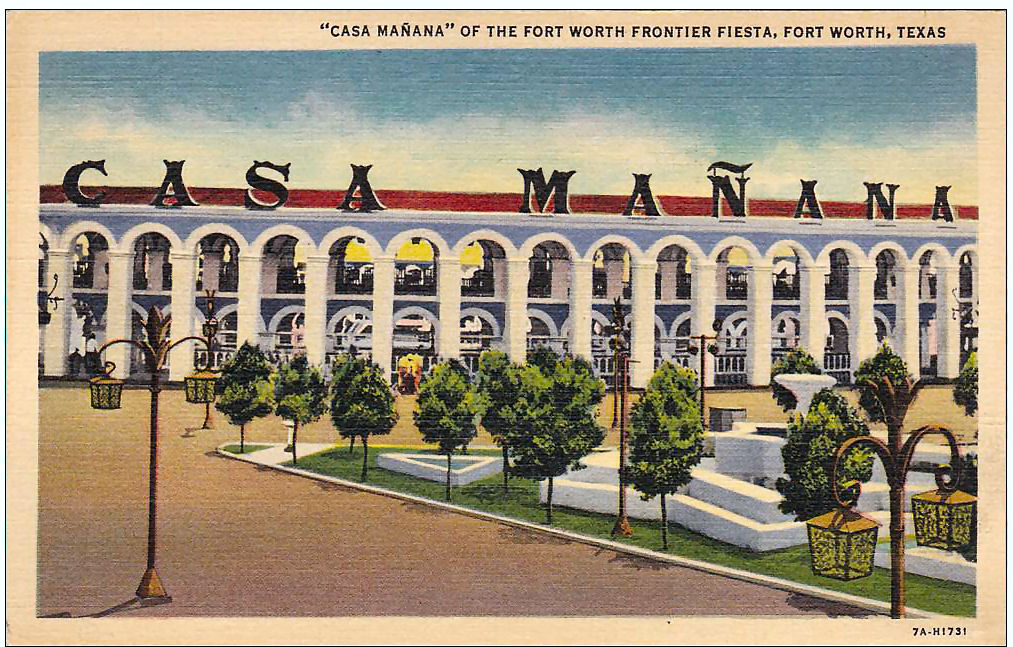 The front of the Mediterranean-style Casa Manana building was painted blue and white, curved almost three hundred feet, and was pierced by more than thirty arches. The arches were repeated on the other side of a promenade, which followed the contour of the front.
The front of the Mediterranean-style Casa Manana building was painted blue and white, curved almost three hundred feet, and was pierced by more than thirty arches. The arches were repeated on the other side of a promenade, which followed the contour of the front.

This photo shows Casa Manana under construction in May 1936. (Photo from University of Texas at Arlington Library.)
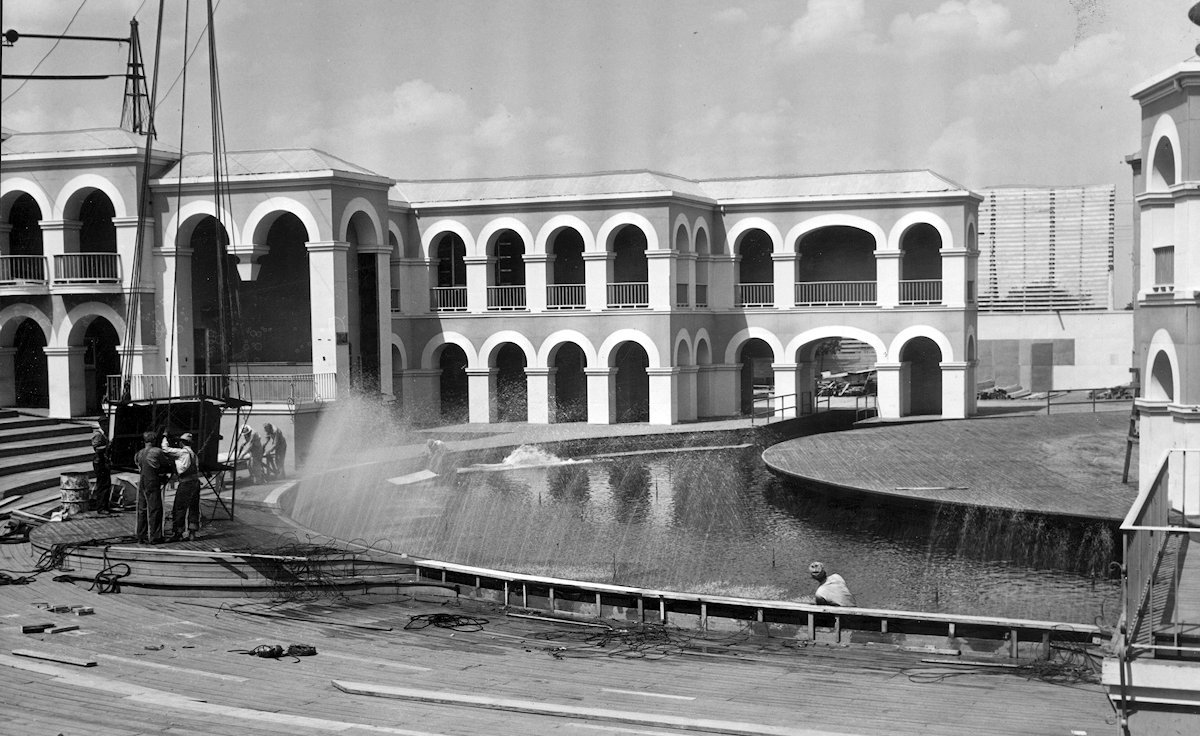
Casa Manana’s stage was unique. It revolved, was 130 feet in diameter, and appeared to float over a lagoon that held 600,000 gallons of water. This construction photo shows the lagoon with its fountains and the circular stage. (Photo from University of Texas at Arlington Libraries Star-Telegram Collection.)
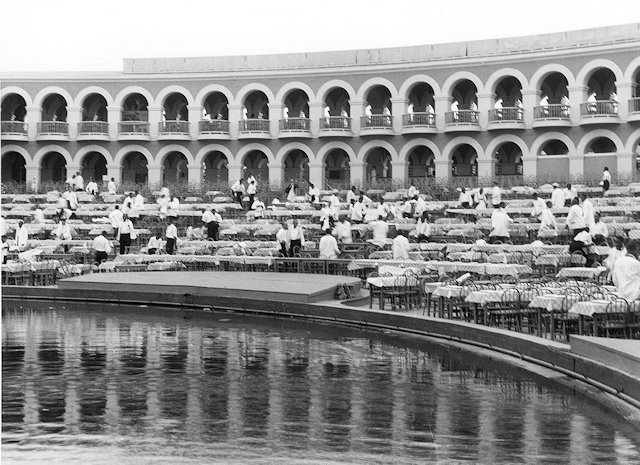
Casa Manana with waiters and water. (Photo from Jack White Photograph Collection, University of Texas at Arlington Libraries.)
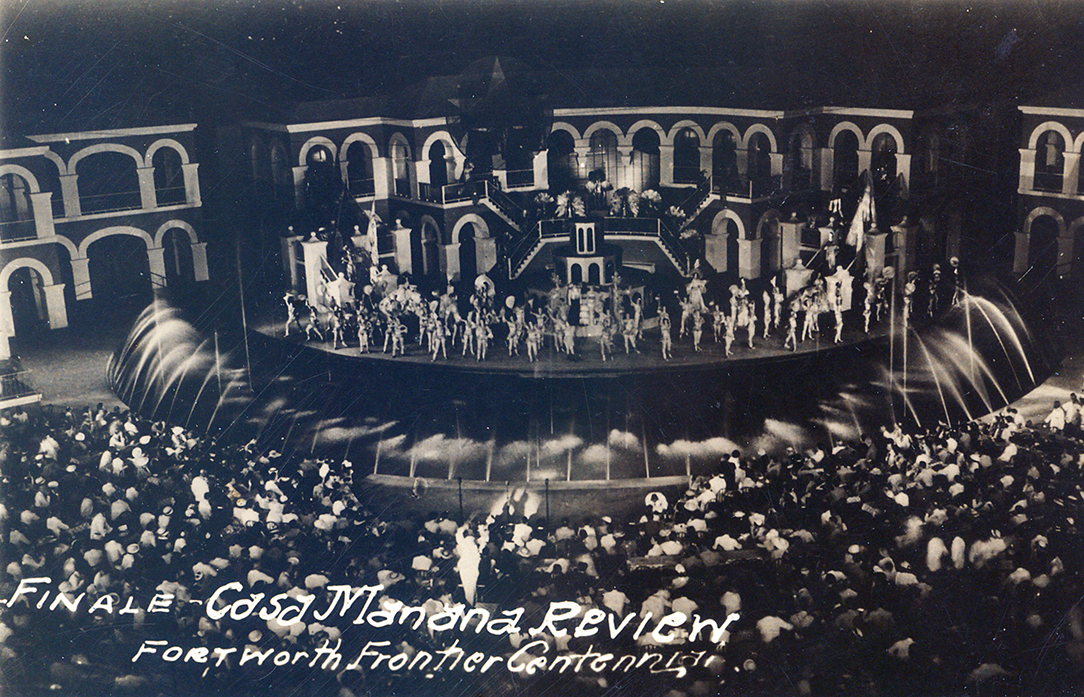
A simple pioneer-days celebration after Amon Carter got hold of it.
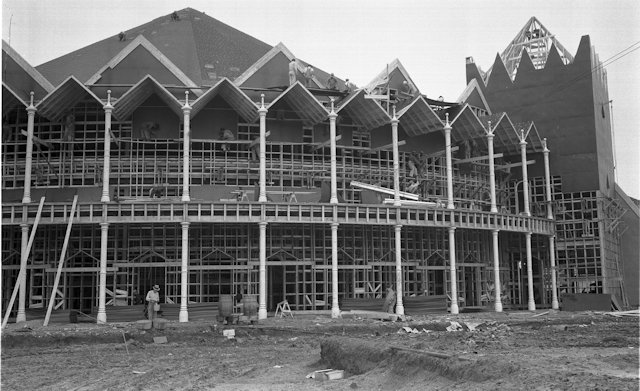
This photo shows construction of the circus building in May 1936. (Photo from University of Texas at Arlington Library.)
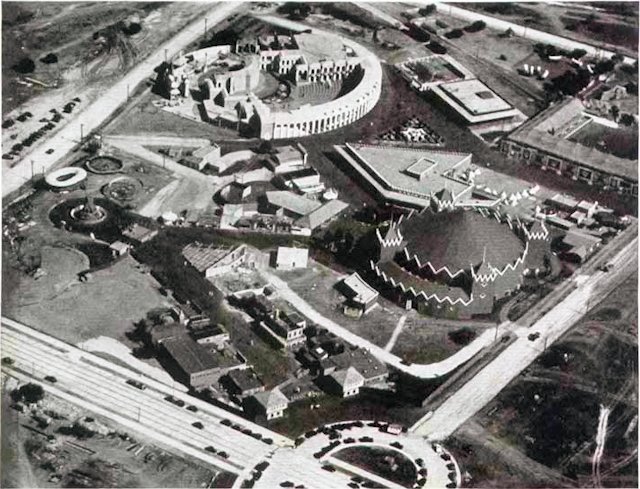 Aerial photo shows the two buildings. Lancaster Avenue is lower left; University Drive is upper left.
Aerial photo shows the two buildings. Lancaster Avenue is lower left; University Drive is upper left.
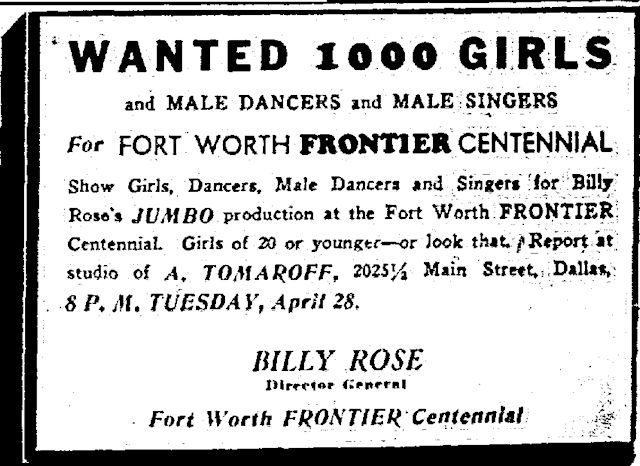 The Frontier Centennial recruited a lot of Fort Worth performers, such as TCU’s Mary “Punkins” Parker. But Fort Worth wasn’t above fishing downstream and recruiting in Dallas, too. Clip is from the April 27, 1936 Dallas Morning News.
The Frontier Centennial recruited a lot of Fort Worth performers, such as TCU’s Mary “Punkins” Parker. But Fort Worth wasn’t above fishing downstream and recruiting in Dallas, too. Clip is from the April 27, 1936 Dallas Morning News.
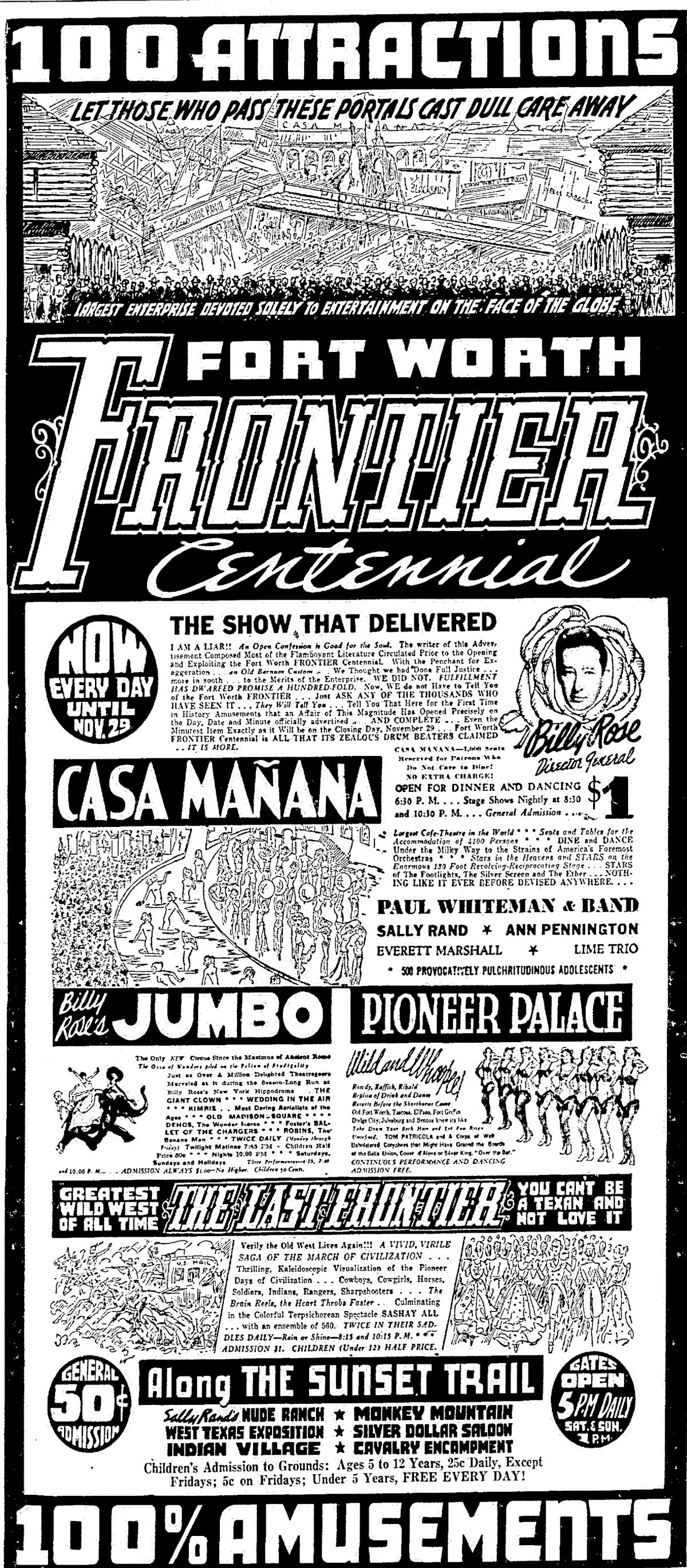 Fort Worth also wasn’t above advertising in Dallas. This Morning News ad of July 26 didn’t bother to merely seduce Dallas readers—it sledgehammered them: “Largest enterprise devoted solely to entertainment on the face of the globe.” “You can’t be a Texan and not love it.” Oh, and the fine print: “500 provocatively pulchritudinous adolescents.” Mercy!
Fort Worth also wasn’t above advertising in Dallas. This Morning News ad of July 26 didn’t bother to merely seduce Dallas readers—it sledgehammered them: “Largest enterprise devoted solely to entertainment on the face of the globe.” “You can’t be a Texan and not love it.” Oh, and the fine print: “500 provocatively pulchritudinous adolescents.” Mercy!
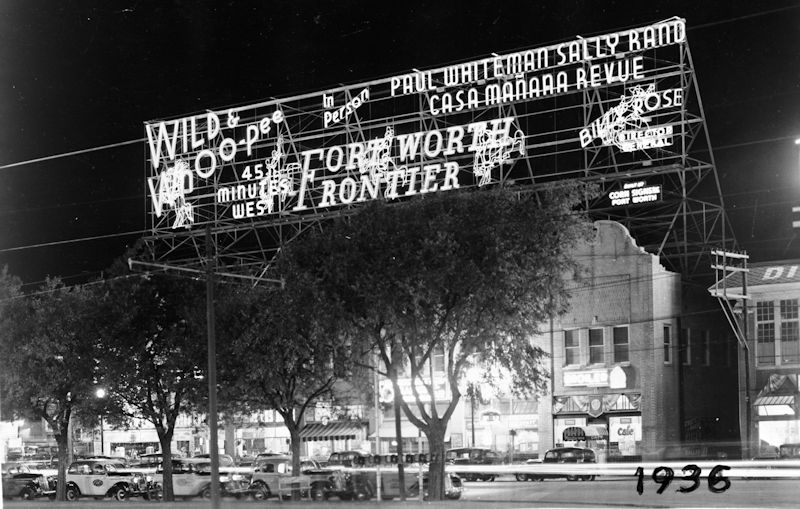
In fact, Fort Worth erected this sign to advertise the “wild & whoo-pee” centennial. (Photo from University of Texas at Arlington Libraries W. D. Smith Commercial Photography Collection.)
And where was the sign erected?
 On Parry Street in Dallas opposite the entrance to the state fair! The building (left) still stands. The state fair ground is on the right.
On Parry Street in Dallas opposite the entrance to the state fair! The building (left) still stands. The state fair ground is on the right.
Fort Worth was Amon Carter’s town, and Fort Worth’s Frontier Centennial became Amon Carter’s pet project. And for his pet project he had no interest in anything less than superlatives: the biggest, the brightest, the boldest, and, yes, the most “provocatively pulchritudinous.” So, when it came time to select someone to ceremonially open the big wingding on July 18, 1936, who popped into Carter’s Stetsoned head?
Hmmm. How about the leader of the free world? Is he available?
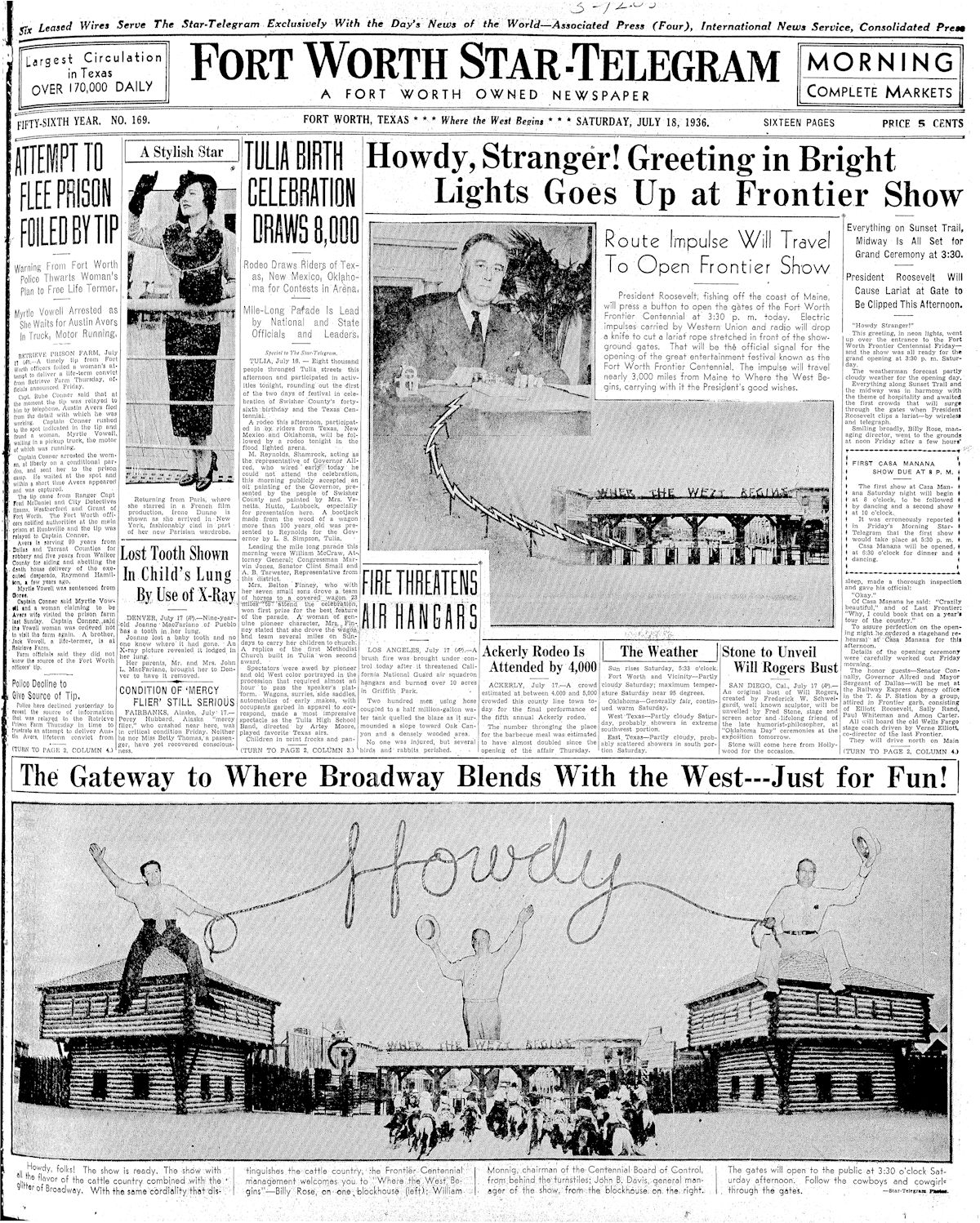 Well, no. Not exactly. Turns out that President Franklin Delano Roosevelt was fishing off the coast of Maine at the time. But if there was one thing Amon Carter could do it was finagle. And finagle he did. To open the Frontier Centennial celebration, FDR, on his schooner in the Atlantic Ocean, would press the key of a wireless transmitter and by radio and telegraph cut a lariat stretched across the entrance to the Frontier Centennial grounds 1,500 miles away.
Well, no. Not exactly. Turns out that President Franklin Delano Roosevelt was fishing off the coast of Maine at the time. But if there was one thing Amon Carter could do it was finagle. And finagle he did. To open the Frontier Centennial celebration, FDR, on his schooner in the Atlantic Ocean, would press the key of a wireless transmitter and by radio and telegraph cut a lariat stretched across the entrance to the Frontier Centennial grounds 1,500 miles away.
(Three years later Amon Carter would again finagle as he lobbied FDR to let Fort Worth have the bomber plant.)
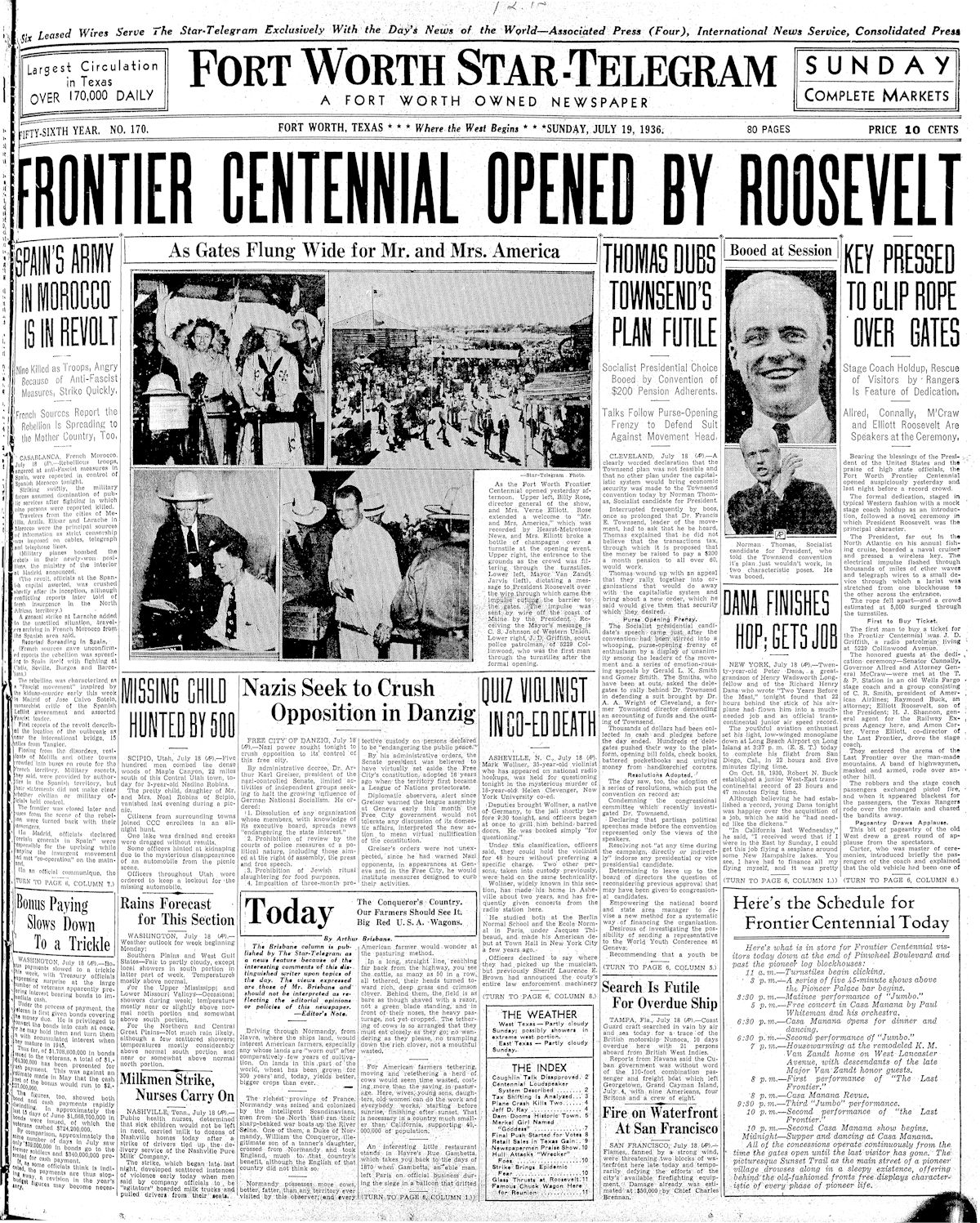 And so it came to pass that on July 18, 1936 it was show time. On his schooner in the Atlantic FDR dutifully pressed a button, and the gates of Fort Worth’s Frontier Centennial were “flung wide for Mr. and Mrs. America.”
And so it came to pass that on July 18, 1936 it was show time. On his schooner in the Atlantic FDR dutifully pressed a button, and the gates of Fort Worth’s Frontier Centennial were “flung wide for Mr. and Mrs. America.”

Arching over the entrance to the centennial grounds was the greeting “Howdy Stranger” in huge letters. After those strangers were inside the vast grounds, they saw plenty of “educational” stuff, all right: displays of Texas history and pioneer handicrafts and a gallery of Western art. But they also saw such spectacles as Billy Rose’s circus musical “Jumbo” with lions, elephants, trapeze artists, clowns, and Monkey Mountain. They saw canals, drawbridges, fountains, and pools. They saw a steam locomotive, Ray Bolger, Don Ameche, “King of Jazz” Paul Whiteman and his orchestra, a gay nineties revue, and the Big Berthas and Six Tiny Rosebuds (two plus-sized women’s dance troupes). They saw slot machines, marionettes, two women tapping out tunes on suspended liquor bottles, a replica of Will Rogers’s den, and side shows with such titles as “Gone with the Wind,” “Lost Horizon,” and “Boudoir Secrets.”
Visitors included Ernest Hemingway, Vice President John Nance Garner, J. Edgar Hoover, boxer Max Baer, U.S. Senator Tom Connally, Governor James V. Allred, Major Jimmy Doolittle, even the mayor of Dallas. The official greeter was pioneer auto racer Barney Oldfield.
Bottom photo shows Billy Rose at the microphone and Amon Carter on the left behind Rose.
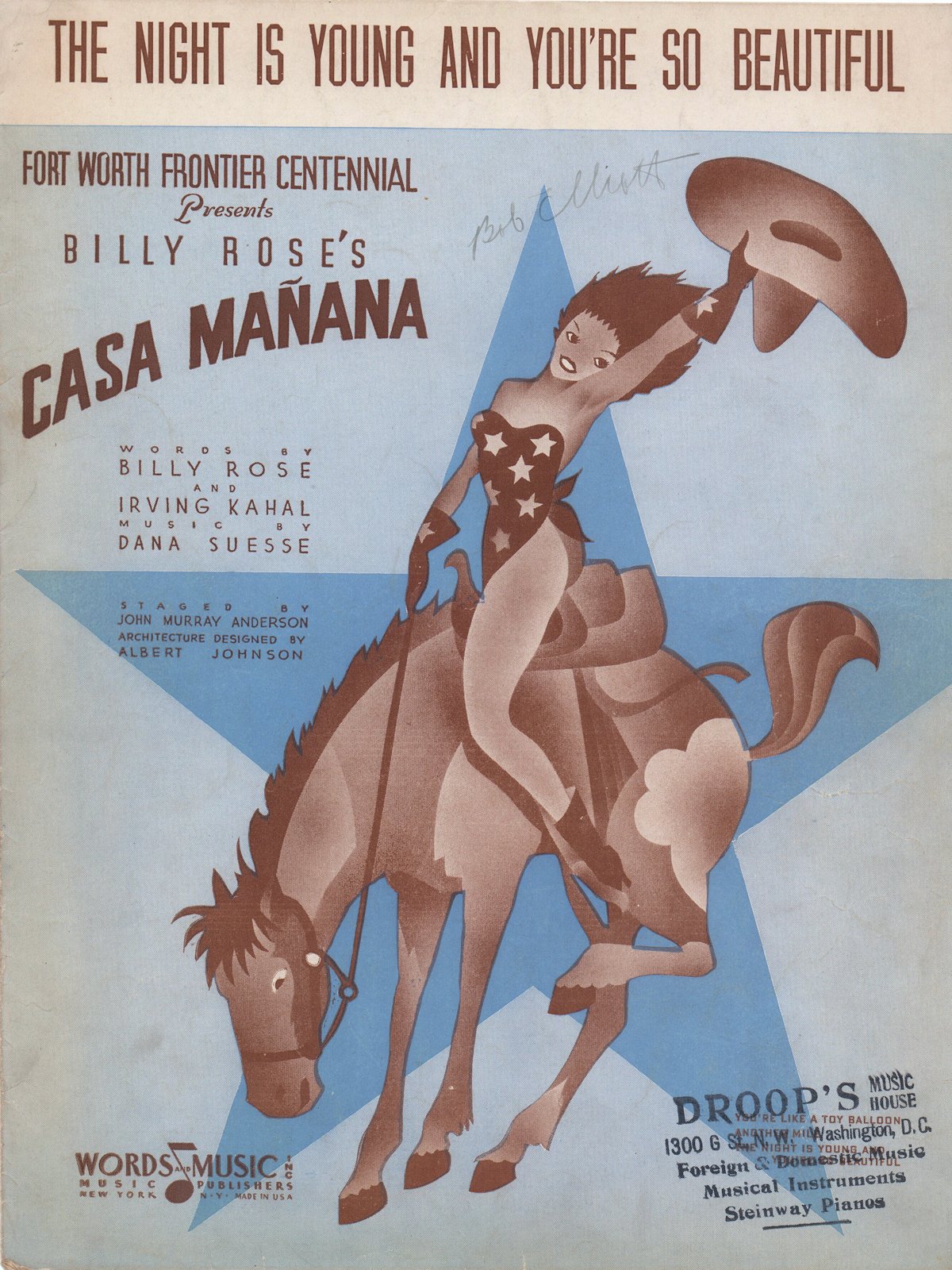 And all those strangers heard the song “The Night Is Young and You’re So Beautiful,” which was introduced at Casa Manana and became the unofficial theme song of the centennial celebration.
And all those strangers heard the song “The Night Is Young and You’re So Beautiful,” which was introduced at Casa Manana and became the unofficial theme song of the centennial celebration.
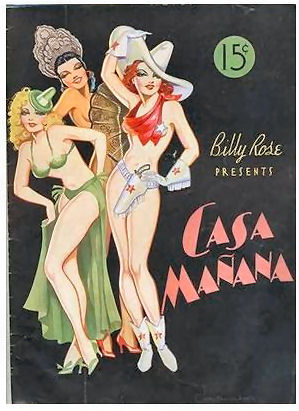 But the Frontier Centennial perhaps is best remembered—at least among the Y-chromosomal set—for Billy Rose’s “Frontier Follies” show at Casa Manana. The Follies featured exotic dancer Sally “I haven’t been out of work since the day I took my pants off” Rand. Rand and her Nude Ranch girls also performed on the midway, dancing behind big feathers and even bigger translucent bubbles (designed for Rand et al. by Goodyear Rubber Company). (Photo from Pete Charlton’s “1000+ Lost Antique Maps of Texas & the Southwest on DVD-ROM.”)
But the Frontier Centennial perhaps is best remembered—at least among the Y-chromosomal set—for Billy Rose’s “Frontier Follies” show at Casa Manana. The Follies featured exotic dancer Sally “I haven’t been out of work since the day I took my pants off” Rand. Rand and her Nude Ranch girls also performed on the midway, dancing behind big feathers and even bigger translucent bubbles (designed for Rand et al. by Goodyear Rubber Company). (Photo from Pete Charlton’s “1000+ Lost Antique Maps of Texas & the Southwest on DVD-ROM.”)
Amon Carter is said to have seen Rand’s show sixty times.
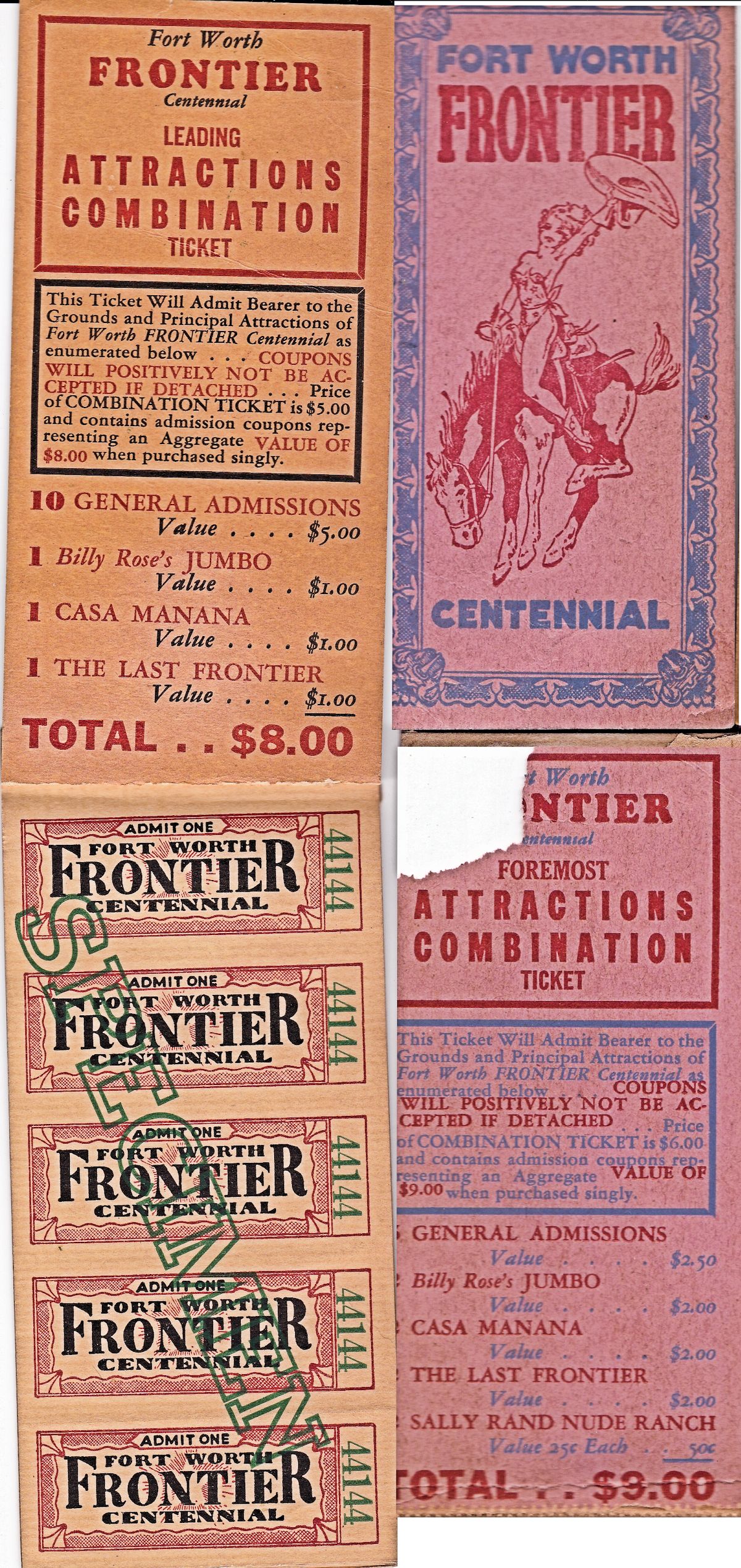 Ticket books donated by Ellen M. Leemann.
Ticket books donated by Ellen M. Leemann.
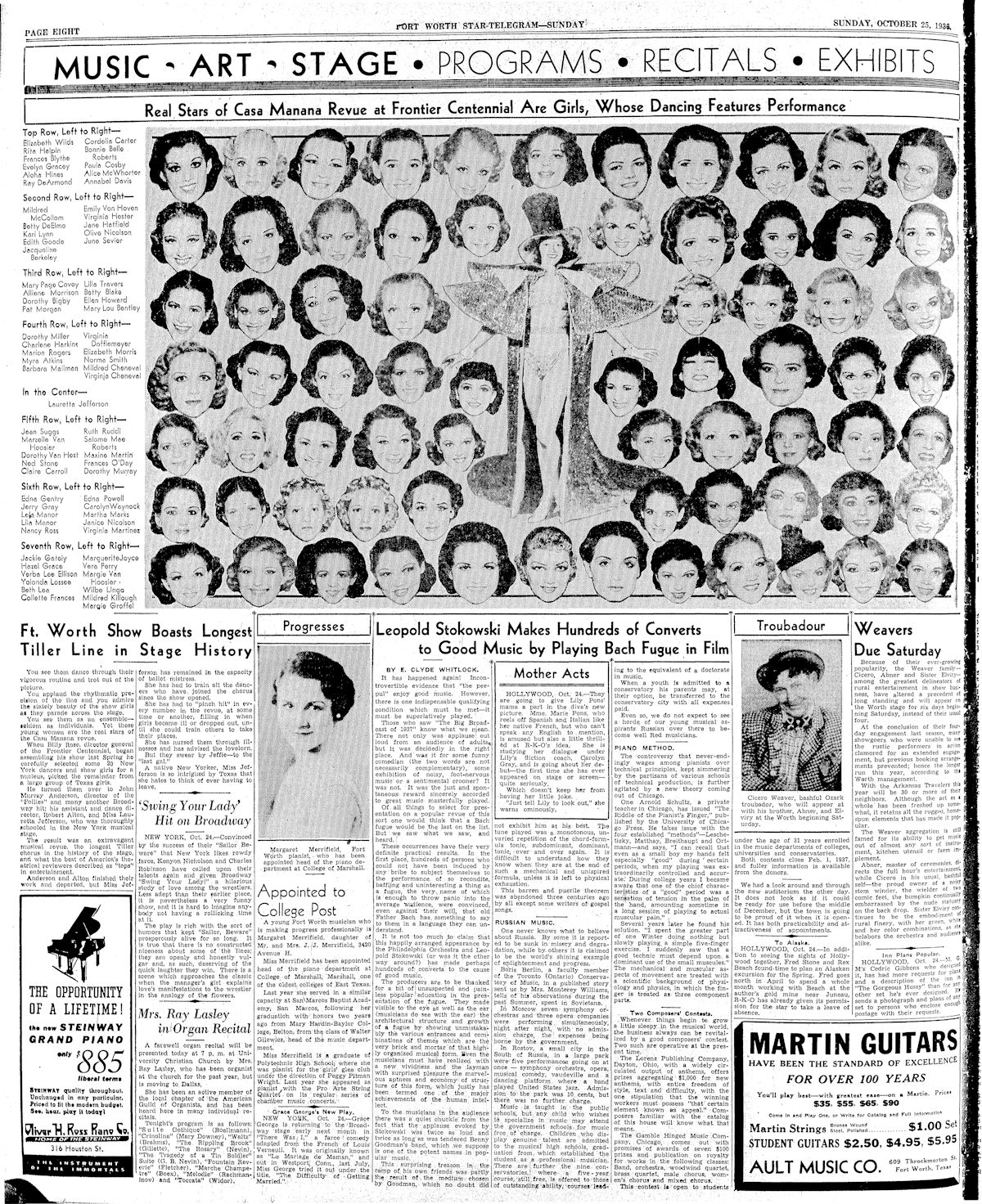 Dancers in the Casa Manana revue were women from New York and from Fort Worth, including Dorothy Murray.
Dancers in the Casa Manana revue were women from New York and from Fort Worth, including Dorothy Murray.
Carter was determined that Carter media—the Star-Telegram and radio station WBAP—would give the centennial the coverage it deserved. During the weeks leading up to and throughout the run of the celebration, the newspaper printed thousands of column inches of words and dozens of photos of every conceivable aspect of the celebration, no matter how trivial. The Star-Telegram news desk must have issued standing orders to reporters: “Don’t come back without a story. Lots of stories.”
And they did. A sample:
 WBAP radio and the NBC radio network would broadcast the opening of the centennial with microphones placed at the “most interesting spots of centennial grounds.”
WBAP radio and the NBC radio network would broadcast the opening of the centennial with microphones placed at the “most interesting spots of centennial grounds.”
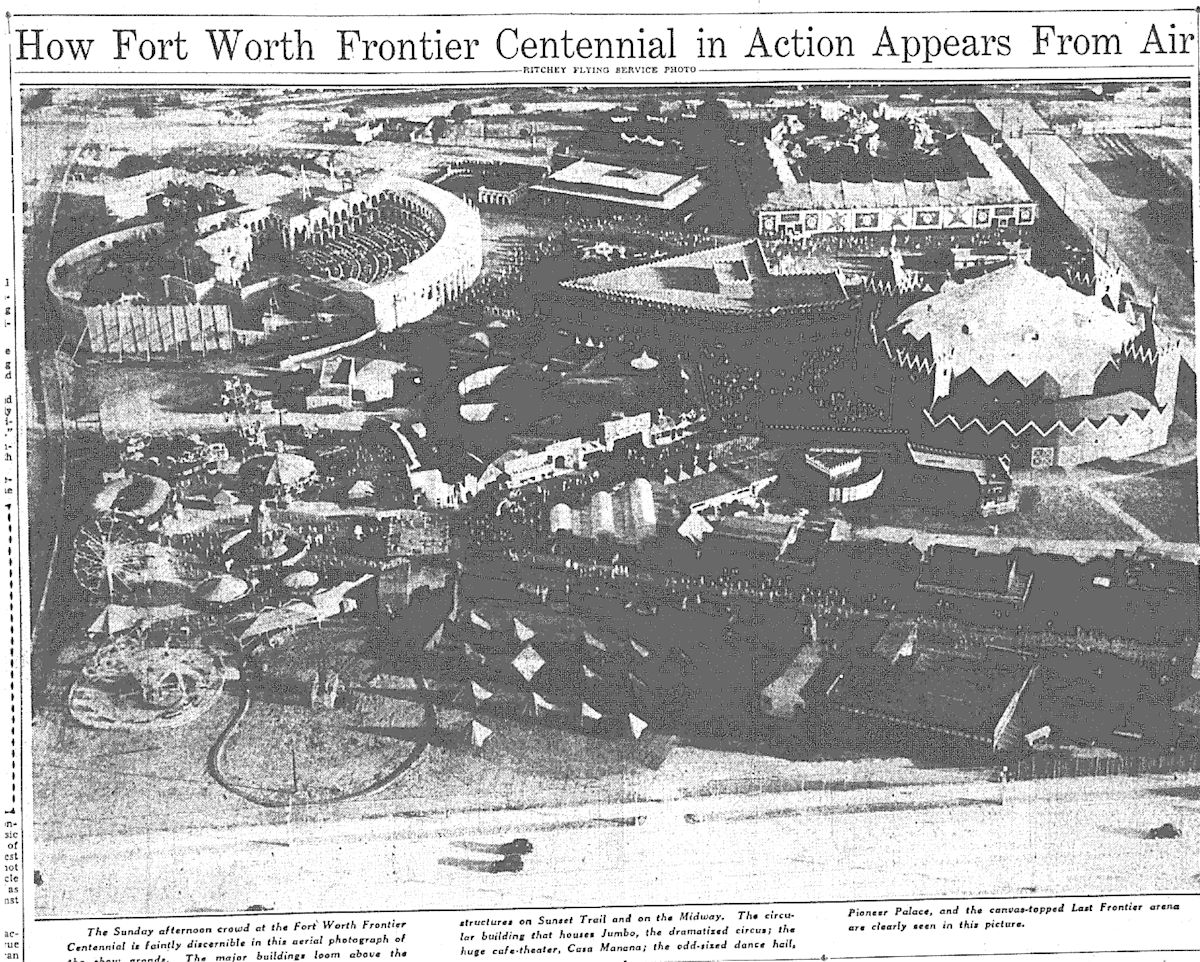
This aerial photo was published on July 21.
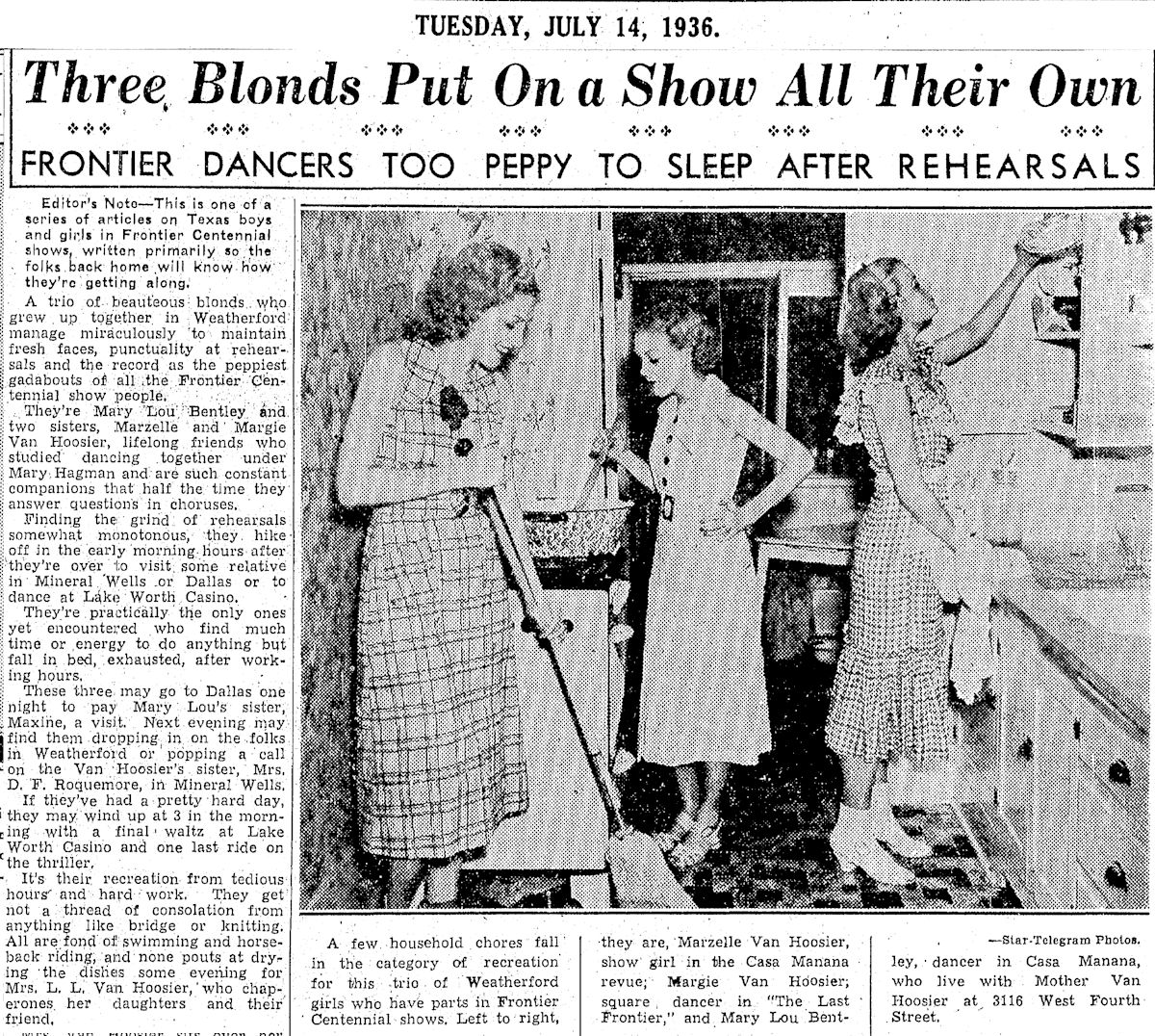 The newspaper published a series of articles about out-of-town centennial performers so that friends and family back home would know how they were doing in the big city. This feature was about three girls from Weatherford who, when too keyed up to sleep after rehearsals, relaxed by doing housework.
The newspaper published a series of articles about out-of-town centennial performers so that friends and family back home would know how they were doing in the big city. This feature was about three girls from Weatherford who, when too keyed up to sleep after rehearsals, relaxed by doing housework.

The centennial insinuated its way onto the front page of the society section, too. If people were in town to visit relatives but also planned to see the centennial, that fact was mentioned. Members of local women’s clubs acted as hostesses at the centennial.
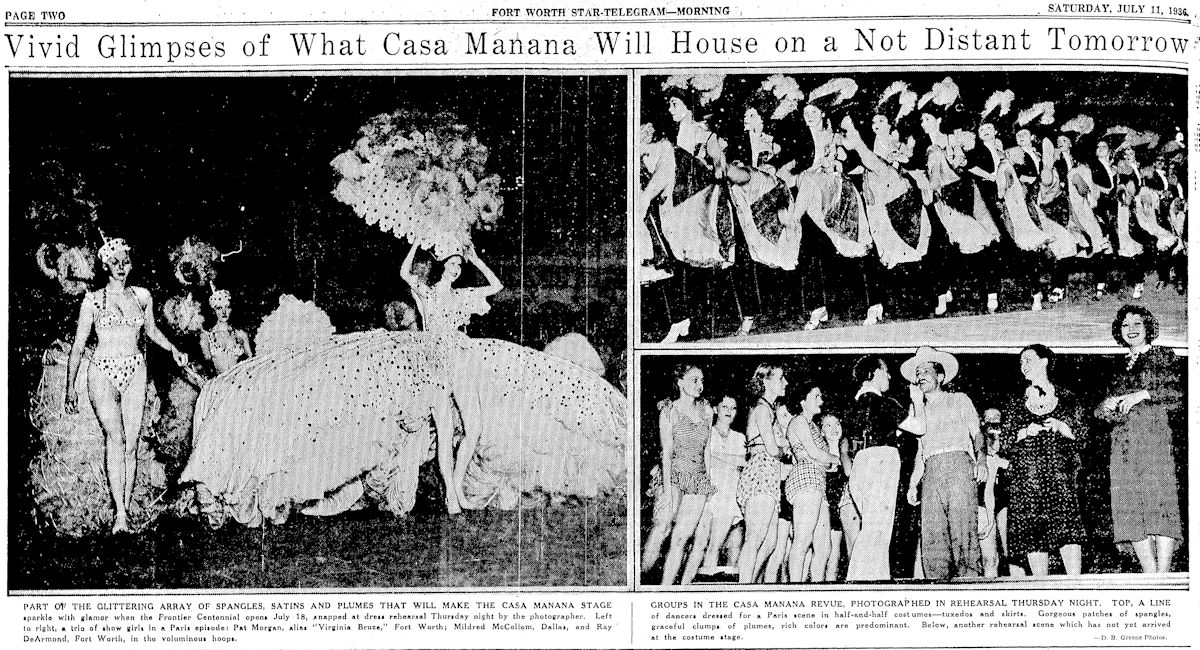 These are photos of rehearsals at Casa Manana.
These are photos of rehearsals at Casa Manana.
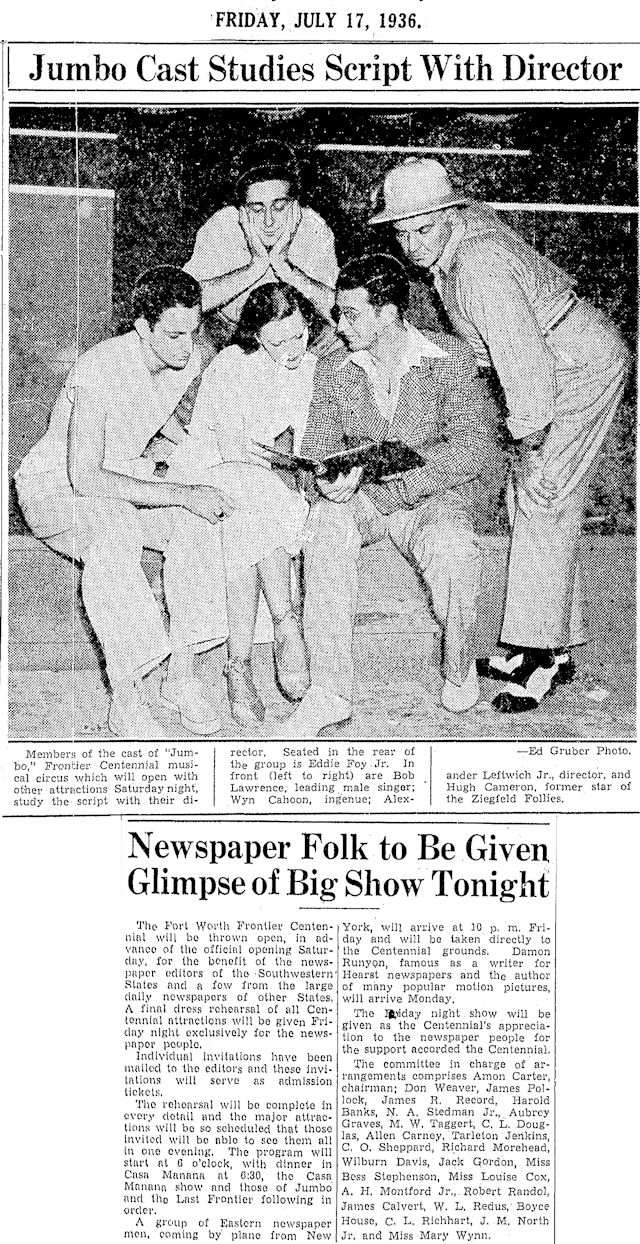 As opening day neared, the cast and director of Billy Rose’s “Jumbo” musical circus conferred.
As opening day neared, the cast and director of Billy Rose’s “Jumbo” musical circus conferred.
And naturally the “read carpet” was rolled out for members of the press, including Damon Runyon. Among those on the arrangements committee were Amon Carter, Jack Gordon, Boyce House, and C. L. Richhart.
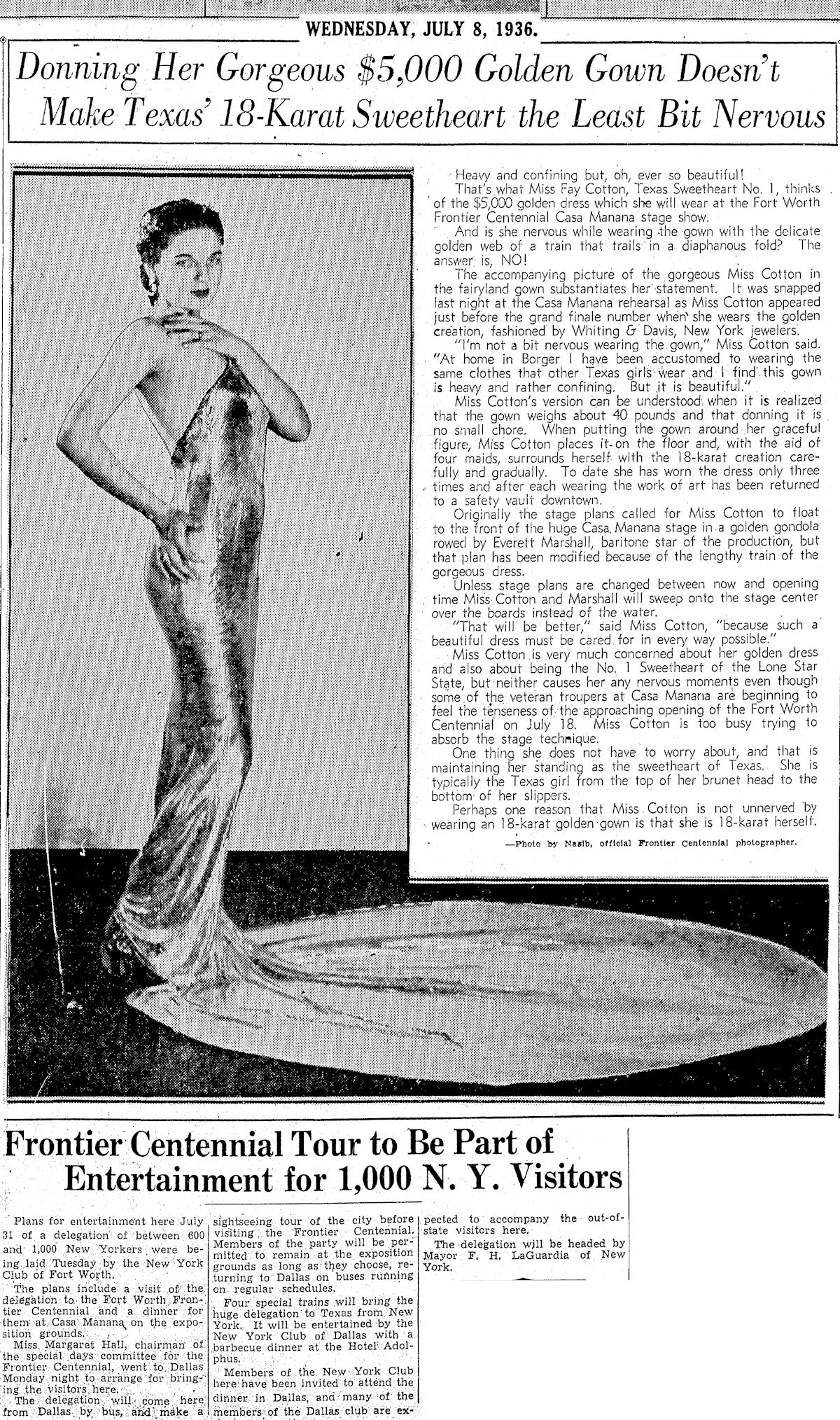 For the celebration, Fay Cotton, who was Texas Sweetheart No. 1, wore a $5,000 ($86,000 today) gown made of fourteen-karat gold.
For the celebration, Fay Cotton, who was Texas Sweetheart No. 1, wore a $5,000 ($86,000 today) gown made of fourteen-karat gold.
And one thousand New Yorkers, including Mayor LaGuardia, planned to attend the centennial, hosted by members of Fort Worth’s New York Club (Fort Worth’s New York Club? Who knew?).
 “Go Elsewhere for Education, Come to Fort Worth for Entertainment.”
“Go Elsewhere for Education, Come to Fort Worth for Entertainment.”
“WILD and WHOO=pee!!!”
’Nuff said.
 “Yippee!” “Whoopee!” “Girls! Girls! Girls!” “Laurene NeVell” and “7 man eating lions” “in a thrilling, exciting dance of death.”
“Yippee!” “Whoopee!” “Girls! Girls! Girls!” “Laurene NeVell” and “7 man eating lions” “in a thrilling, exciting dance of death.”
’Nuff said.
 Everything that happened at the centennial—even a naughty breeze—and especially if that naughty breeze teased Sally Rand—was grist for the copy mill of Carter’s Star-Telegram.
Everything that happened at the centennial—even a naughty breeze—and especially if that naughty breeze teased Sally Rand—was grist for the copy mill of Carter’s Star-Telegram.
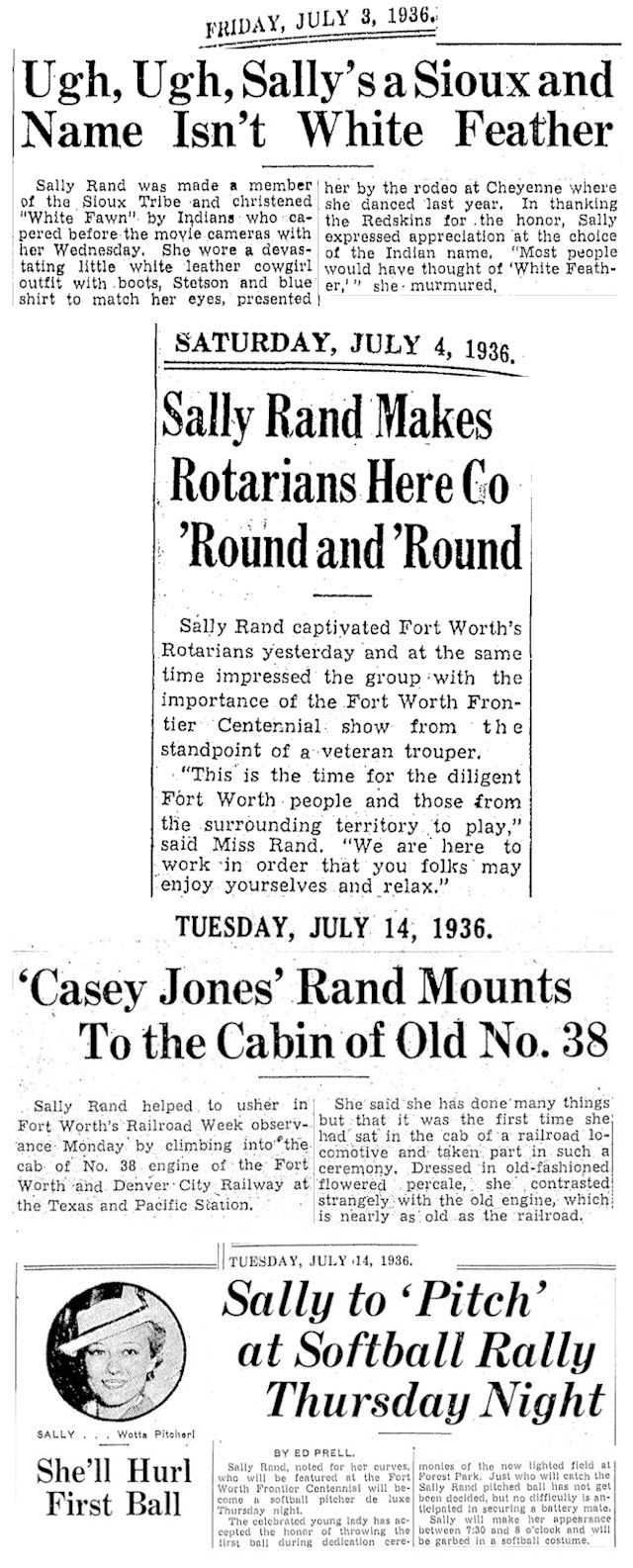
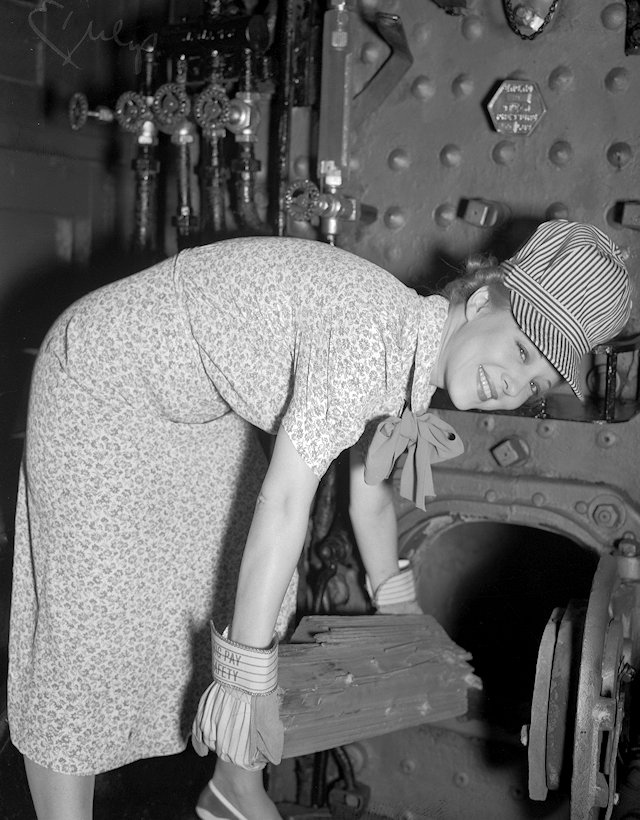
During her time in Fort Worth, Sally Rand was everywhere. When she was not on stage, attending to her nudie duties, working her feathers to the bone, she was out mixing in the community, becoming an honorary Sioux one day, speaking to Rotarians and throwing the first pitch at a softball field in Forest Park another day. In the photo above, she is helping to promote Fort Worth’s Railroad Week by loading a log into the fire box of a locomotive. (Photo from University of Texas at Arlington.)
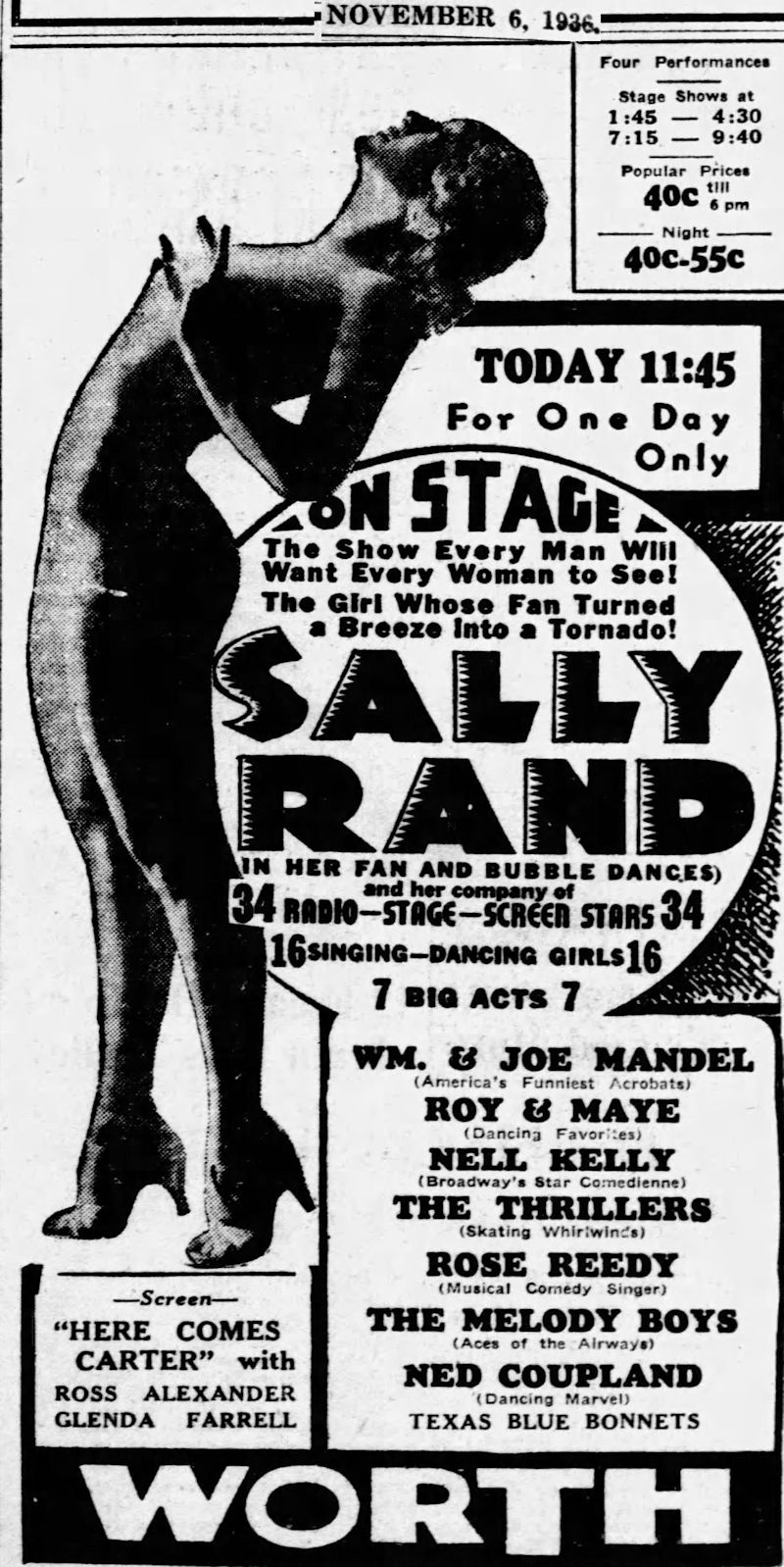 Sally and her fan even found time to perform on the stage of the Worth Theater.
Sally and her fan even found time to perform on the stage of the Worth Theater.
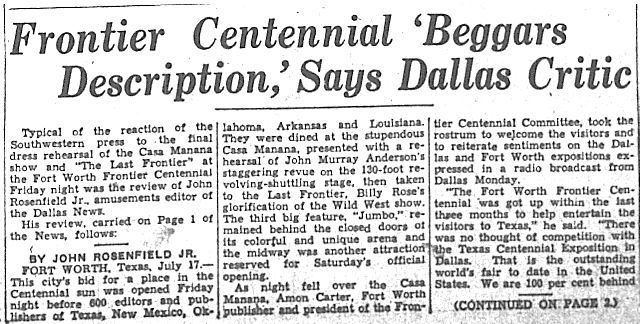 How Amon Carter must have gloated when a Dallas critic used the words stupendous and staggering in reference to the centennial. And how firmly Carter’s tongue must have been in his cheek when he said, “There was no thought of competition with the Texas Centennial Exposition in Dallas.”
How Amon Carter must have gloated when a Dallas critic used the words stupendous and staggering in reference to the centennial. And how firmly Carter’s tongue must have been in his cheek when he said, “There was no thought of competition with the Texas Centennial Exposition in Dallas.”
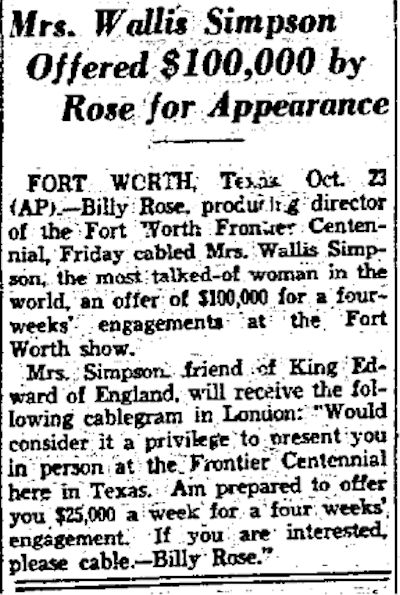 But Billy Rose, like Amon Carter, wanted more. On October 24, 1936 the Dallas Morning News reported that Rose had offered Wallis Simpson $100,000 ($1.6 million today) to appear at the Frontier Centennial for a month. At the time, of course, American socialite Wallis Simpson was the mistress of England’s newly crowned King Edward VIII, who in December would abdicate the throne to marry her.
But Billy Rose, like Amon Carter, wanted more. On October 24, 1936 the Dallas Morning News reported that Rose had offered Wallis Simpson $100,000 ($1.6 million today) to appear at the Frontier Centennial for a month. At the time, of course, American socialite Wallis Simpson was the mistress of England’s newly crowned King Edward VIII, who in December would abdicate the throne to marry her.
To Wallis Simpson is attributed this maxim: “Fill what’s empty, empty what’s full, and scratch where it itches.”
Rose’s offer apparently did not make Wallis itch. She declined his scratch, and Sally Rand had to keep top billing all to herself.
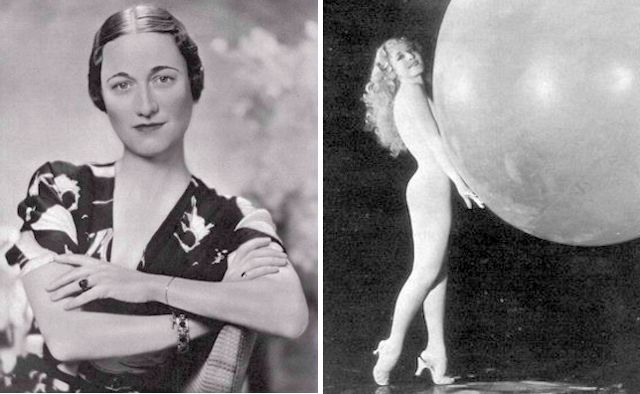 Wallis Simpson and Sally Rand: the show biz pairing that was not to be.
Wallis Simpson and Sally Rand: the show biz pairing that was not to be.
Wallis Simpson’s no-show notwithstanding, somehow what Amon Carter and Billy Rose wrought worked and worked wondrously: What began modestly with plans for Boy Scouts to simulate Indians by wearing feathers had evolved into Sally Rand and her Nude Ranchers wearing feathers. During the summer of 1936 the Frontier Centennial drew almost one million people.
As for the centerpiece of the Frontier Centennial, Casa would see more mananas: It stayed open through the 1939 season.
 But the theater suffered contract problems, and in 1940 the stage went dark.
But the theater suffered contract problems, and in 1940 the stage went dark.
 In 1941, as America went to war, the city pondered what to do with the building and the land under it. A Star-Telegram editorial said the land was being considered as the location of a new technical high school. Instead the school district converted the North Fort Worth High School building into a technical school. In 1955 the technical high school moved to the former building of Paschal High School and later was renamed “Green B. Trimble Technical High School.”
In 1941, as America went to war, the city pondered what to do with the building and the land under it. A Star-Telegram editorial said the land was being considered as the location of a new technical high school. Instead the school district converted the North Fort Worth High School building into a technical school. In 1955 the technical high school moved to the former building of Paschal High School and later was renamed “Green B. Trimble Technical High School.”
 As with so many buildings, in 1942 the wrecking ball came for Casa. It was dismantled, its fixtures sold in the classified ads like bric-a-brac at an estate sale. Its steel revolving stage was sacrificed to the war effort. Scrap metal from collection drives was piled on the former site of the centennial.
As with so many buildings, in 1942 the wrecking ball came for Casa. It was dismantled, its fixtures sold in the classified ads like bric-a-brac at an estate sale. Its steel revolving stage was sacrificed to the war effort. Scrap metal from collection drives was piled on the former site of the centennial.
 But on July 5, 1958, with a “yes, we ‘Can-Can’” determination, the second Casa Manana opened just a few yards north of its predecessor. Among those attending the opening of the geodesic theater-in-the-round was hometown king of the wild frontier Fess Parker.
But on July 5, 1958, with a “yes, we ‘Can-Can’” determination, the second Casa Manana opened just a few yards north of its predecessor. Among those attending the opening of the geodesic theater-in-the-round was hometown king of the wild frontier Fess Parker.
By the time the second Casa Manana opened, Amon Carter had been dead three years. On opening night, a mile north of the theater in Carter’s mausoleum at Greenwood Cemetery, his spirit probably tapped in time to the musical’s tunes, but his spirit probably imagined Sally Rand in the lead role.
British Pathe coverage of the Frontier Centennial on YouTube (no audio):
Sally Rand performing her fan-dango in 1942:






I wonder whatever happened to that fabulous, spectacular $5,000 14k dress?
My guess is we don’t want to know.
Great read. I have a photo of my Mom with the Frontier Centennial banner She looks very happy,guess she was having a good time Thanks
Thanks, Peggy.
What an exciting time to be alive! My Dad was just a 16-year old teenager but lived too far away to attend. He didn’t make it to Texas until after the war started, when he was stationed in Abilene, where he married my Mom. How sad that just a few years later Hitler would turn the whole world upside down.
Good point, Dan. All those merrymakers at the centennial were making merry as if the good times would end in five years on a far-away island in the Pacific.
I have a booklet of tickets to the events that belong with this collection. Email with an address and will get them to you.
Got ’em! Thank you so much, Ellen, for your contribution to the memory of one of Fort Worth’s biggest events.
YOUR SITE IS SPECTACULAR! If you would like some more information on the entire festival, I’m happy to share. I’ve never seen all the construction photos of Casa Manana. I’ve been looking for photos of it being dismantled for steel for the war effort.
Thanks, Sarah. I have seen newspaper stories and ads on dismantling Casa, selling the steel, piling scrap metal from collection drives nearby on the site of the centennial, but no photos. The S-T archives at the UTA Library might have some.
I remember it well! I was ten years old, living in Kansas City, Mo. We had gone to Dallas to visit relatives and, of course, we HAD to see this! At that age, I couldn’t appreciate the immensity of this affair, but I do remember the thrill and excitement!!
My father was Billy Rose’s auditor at the Centennial. During the fair there was a threatened waiter’s strike at the Casa Mañana led by Calvin Littlejohn, later to become a famed Fort Worth photographer and recorder of black life in America. My father was largely instrumental in resolving the wage dispute in favor of the waiters, and in appreciation Mr. Littlejohn presented him with a painting he had done of his boyhood home in Arkansas. I was seven at the time and always kept the painting in my room wherever we went, and it now hangs in my Tokyo home. I wonder if anyone remembers this early civil rights incident and might have any press coverage concerning it?
My Mother spoke of this amazing show. She was 10 years old. I have some newspaper clippings she put in a scrap book!
Thanks for this archive
As always Mike great story i’ve read several comment on the post Pete put on facebook…great 2 see others interested fw history. Thanks for your work.
Thanks, Dale. What a show that must have been.
Thanks, Mike, for covering the 1936 Frontier Continental. My family was fortunate enough to attend a performance at Casa Manana, courtesy of my Dad’s employer, TP Coal & Oil Company. As a 6 year old, I was thrilled by the Wild West show. Many companies had displays selling everything from saddles to automobiles. My eye was caught by the Ford company display, where before my very eyes, toy automobiles were manufactured, on an assembly line, from molten rubber poured into casts, fitted with wheels and colored either red or black depending on the buyer’s desire. That little car was a cherished toy, eventually lost in the fog of time. Dad also took me for a ride on the ferris wheel, which “accidently” was erected next to Sally Rand’s Nude Ranch. The “Ranch” had no roof, so many of the “cowgirls” were plainly visible from the ride. I didn’t understand why my mother was angry at my father until many years later.
Great anecdote, George!